The Pietà | A Masterpiece by Michelangelo Merisi da Caravaggio
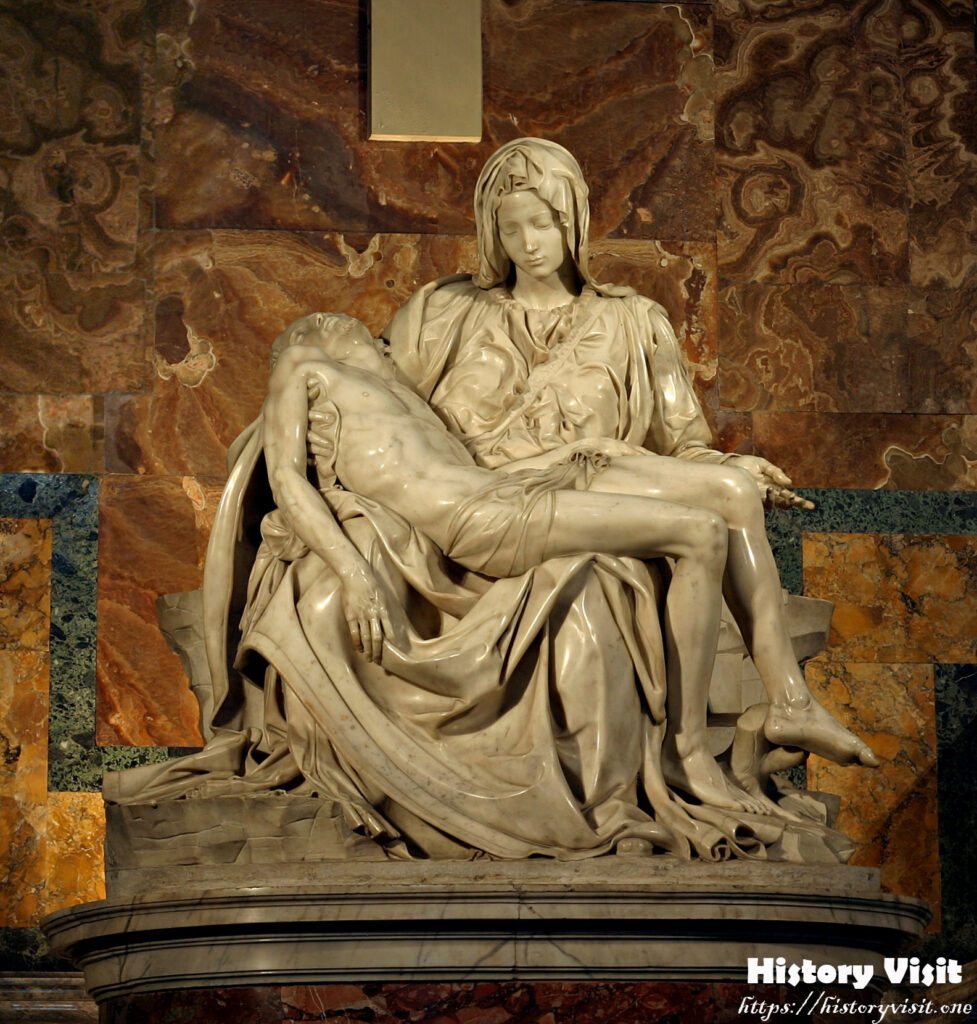
Brief overview of “The Famous Pietà”
“The Famous Pietà” is a masterpiece sculpture created by the Italian artist Michelangelo. It portrays the body of Jesus Christ in the arms of his mother Mary after the Crucifixion. Carved from a single block of marble, the sculpture is celebrated for its exquisite craftsmanship, emotional intensity, and profound spiritual depth. Housed in St. Peter’s Basilica in Vatican City, “The Pietà” is considered one of the greatest works of Renaissance art, captivating viewers with its portrayal of maternal grief and divine grace.
Importance and significance of the sculpture
“The Pietà” holds immense importance and significance both artistically and culturally
- Artistic Mastery: Michelangelo’s “The Pietà” demonstrates unparalleled skill in marble sculpting, showcasing his ability to imbue life-like qualities into stone. The sculpture’s intricate details, from the delicate folds of Mary’s garments to the serene expression on her face, highlight Michelangelo’s technical virtuosity.
- Spiritual and Emotional Depth: As a depiction of Mary cradling the lifeless body of her son, Jesus, “The Pietà” evokes profound emotions of sorrow, compassion, and love. It serves as a powerful representation of the Christian faith’s central narrative of redemption through sacrifice, inviting viewers to contemplate the mysteries of divine love and human suffering.
- Symbolism of Motherhood: Mary’s tender embrace of Jesus symbolizes the universal theme of maternal love and sacrifice. The sculpture transcends its religious context to resonate with audiences across cultures and beliefs, speaking to the enduring bond between parent and child and the human experience of loss and mourning.
- Icon of Renaissance Art: “The Pietà” exemplifies the ideals of the Renaissance, characterized by a revival of classical aesthetics, humanism, and naturalism. It stands as a pinnacle of artistic achievement from this period, inspiring generations of artists and shaping the trajectory of Western art history.
- Cultural Heritage: As a treasured masterpiece housed in St. Peter’s Basilica, “The Pietà” is a symbol of the Vatican’s rich artistic heritage and spiritual legacy. It attracts millions of visitors from around the world each year, serving as a beacon of beauty, faith, and contemplation for all who encounter it.
Brief biography of Michelangelo
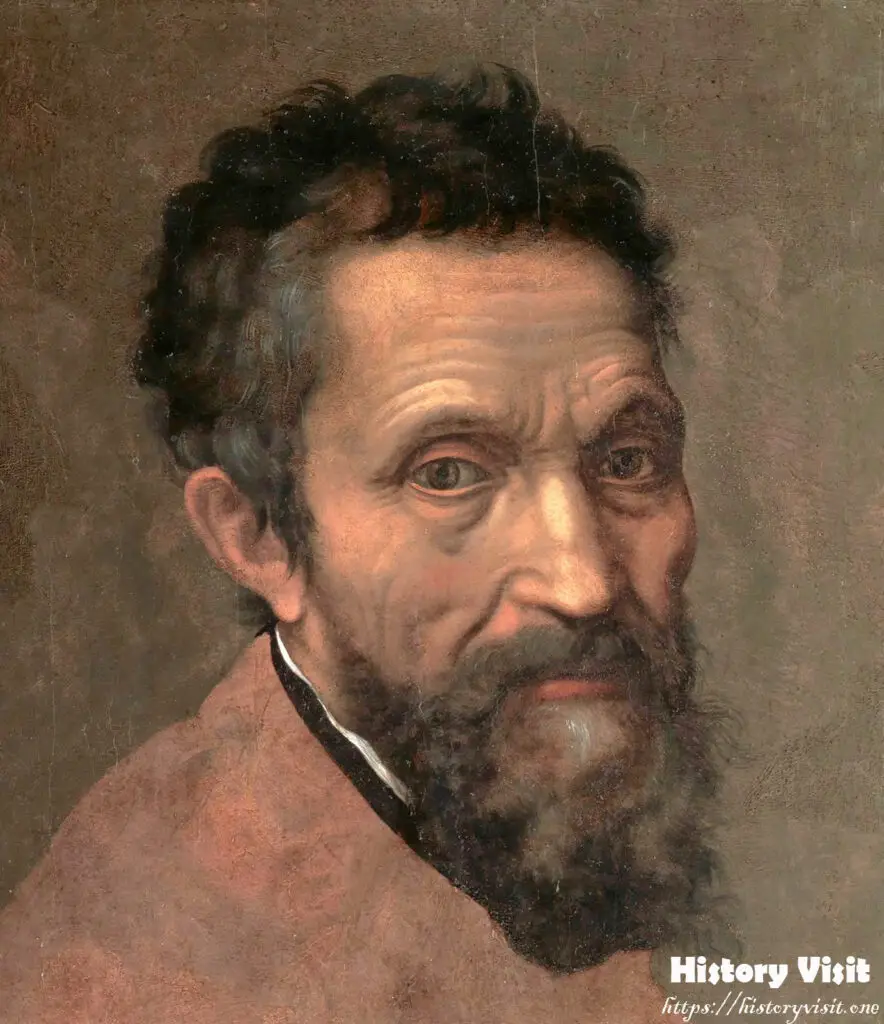
Michelangelo Buonarroti, often referred to simply as Michelangelo, was one of the most influential artists of the Italian Renaissance. Here’s a brief overview of his life
- Early Life: Michelangelo was born on March 6, 1475, in Caprese, Italy, to a family of modest means. He grew up in Florence, where his father recognized his artistic talent and apprenticed him to the painter Domenico Ghirlandaio.
- Artistic Training: Despite his initial training as a painter, Michelangelo’s passion for sculpture led him to study under the sculptor Bertoldo di Giovanni and later at the Medici Academy in Florence. His early works, such as the “Battle of the Centaurs” and the “Pieta,” showcased his exceptional talent and caught the attention of prominent patrons.
- Patronage of the Medici: Michelangelo’s talent soon attracted the patronage of Lorenzo de’ Medici, the ruler of Florence, and his family. Under their support, he created some of his most famous works, including the “David,” a monumental marble statue that became an enduring symbol of Florentine pride and the ideal of human perfection.
- Papal Patronage: Michelangelo’s reputation as a sculptor and artist continued to grow, leading to commissions from various popes in Rome. He is best known for his work on the ceiling of the Sistine Chapel, where he spent four years painting the iconic frescoes depicting scenes from Genesis, including the creation of Adam and the Last Judgment.
Later Works and Legacy: In addition to his sculptural and painting achievements, Michelangelo was also an accomplished architect, poet, and engineer. His later works include the design of St. Peter’s Basilica’s dome in Vatican City and the sculpture of the “Pietà Rondanini.” Michelangelo’s artistic legacy endures to this day, influencing countless artists and leaving an indelible mark on the history of Western art. He died on February 18, 1564, in Rome, at the age of 88, leaving behind a vast body of work that continues to inspire and captivate audiences around the world.
Context of the creation of “The Pietà”

“The Pietà” was created by Michelangelo between 1498 and 1499 when he was in his early twenties. The context of its creation is significant for understanding both the artist’s career and the broader cultural and artistic milieu of the time
- Early Career: At the time Michelangelo created “The Pietà,” he was already establishing himself as a rising star in the art world. His talent had garnered attention, and he had received several prestigious commissions, including the “Pieta” for the French cardinal Jean de Billheres. This work would serve as Michelangelo’s introduction to the Roman artistic community.
- Renaissance Florence: Michelangelo hailed from Florence, a vibrant center of art, culture, and humanism during the Italian Renaissance. The city’s intellectual and artistic climate, fueled by the patronage of wealthy families like the Medici, provided fertile ground for the development of Michelangelo’s artistic talents.
- Patronage and Influence: “The Pietà” was commissioned by Cardinal Jean de Billheres for his future tomb in St. Peter’s Basilica in Rome. The cardinal intended the sculpture to showcase his piety and devotion to the Virgin Mary. Michelangelo’s association with the cardinal and his patronage network in Rome would play a crucial role in shaping the trajectory of his career and securing future commissions.
- Cultural and Religious Context: “The Pietà” emerged within the broader context of religious fervor and artistic innovation in Renaissance Italy. It reflects the prevailing religious sentiments of the time, particularly the veneration of Mary as a symbol of divine mercy and maternal compassion. The sculpture’s portrayal of the Virgin Mary mourning the death of Christ resonated deeply with contemporary audiences, eliciting strong emotional responses and affirming the power of art to evoke piety and devotion.
In summary, the creation of “The Pietà” occurred at a pivotal moment in Michelangelo’s early career, as he transitioned from his formative years in Florence to establish himself as a leading artist in Rome. The sculpture’s commission by Cardinal Jean de Billheres and its placement in St. Peter’s Basilica underscored Michelangelo’s growing reputation and marked a significant milestone in his artistic journey.
Physical characteristics of the sculpture
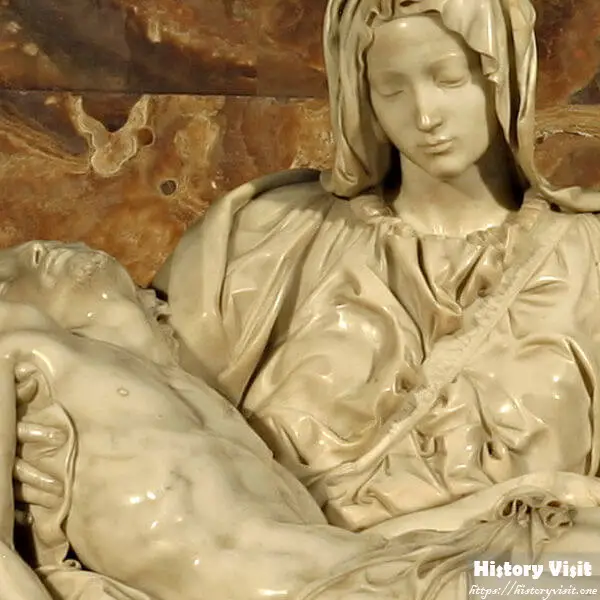
“The Pietà” is renowned for its remarkable beauty and attention to detail. Here are some key physical characteristics of the sculpture
- Composition: “The Pietà” depicts the Virgin Mary seated with the lifeless body of Jesus Christ resting on her lap. Mary’s figure is graceful and serene, while Jesus appears youthful and peaceful despite the wounds of his crucifixion.
- Material: Carved from a single block of Carrara marble, Michelangelo’s mastery of the medium is evident in the sculpture’s smooth surfaces, fluid lines, and subtle textures. The choice of marble allows for exquisite detail and lends the sculpture a sense of permanence and timelessness.
- Proportions: Michelangelo’s skillful manipulation of proportions gives “The Pietà” a sense of harmony and balance. Mary’s figure is larger and more dominant, emphasizing her role as the central figure of the composition, while Jesus appears smaller and more vulnerable in her embrace.
- Expressive Faces: The faces of Mary and Jesus are exquisitely carved to convey a range of emotions. Mary’s expression is one of sorrow and resignation, her eyes downcast in mourning, while Jesus’s face reflects a sense of peacefulness and acceptance, transcending the pain of his suffering.
- Drapery: The intricate folds and drapery of Mary’s robes add to the sculpture’s sense of realism and movement. Michelangelo meticulously carved each fold and crease to create the illusion of fabric clinging to the figures’ bodies, enhancing the sense of drama and emotion in the scene.
- Detailing: Michelangelo paid meticulous attention to anatomical accuracy and naturalistic detail in “The Pietà.” The veins, muscles, and contours of the figures are rendered with extraordinary precision, lending them a sense of lifelike vitality and presence.
Overall, “The Pietà” exemplifies Michelangelo’s consummate skill as a sculptor and his ability to imbue marble with a sense of emotional depth and spiritual transcendence. It remains one of the most celebrated masterpieces of Renaissance art, captivating viewers with its beauty, craftsmanship, and profound expression of faith and compassion.
Symbolism and interpretation
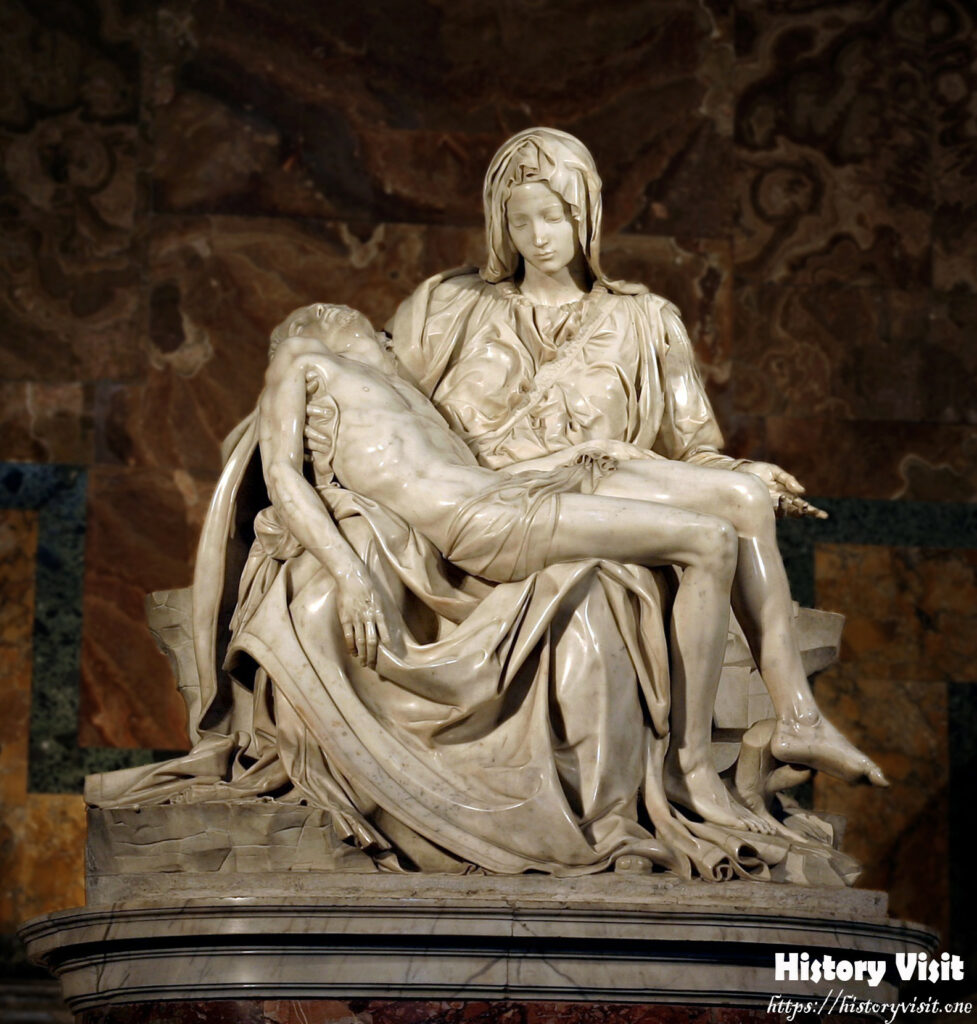
“The Pietà” is rich with symbolism and has been interpreted in various ways throughout history. Here are some of the key symbols and interpretations associated with the sculpture
- Divine Mercy and Compassion: At its core, “The Pietà” symbolizes the Christian concept of divine mercy and compassion. Mary’s tender embrace of her son’s lifeless body reflects the profound love and sorrow of a mother mourning the loss of her child. The sculpture embodies the Christian belief in the redemptive power of Christ’s sacrifice and the promise of salvation through his death and resurrection.
- Virgin Mary as the Mater Dolorosa: Mary’s portrayal as the grieving mother, known as the Mater Dolorosa or Sorrowful Mother, is a central theme in Catholic devotional art. Her sorrowful expression and maternal tenderness evoke empathy and invite viewers to contemplate the human experience of suffering and loss.
- Redemption and Salvation: The juxtaposition of Mary’s sorrow with Jesus’s serene expression conveys a sense of spiritual transcendence and hope. Despite the tragedy of Christ’s death, there is an underlying sense of peace and acceptance, symbolizing the promise of redemption and eternal life for believers.
- Idealized Beauty and Perfection: Michelangelo’s portrayal of Mary and Jesus as idealized figures imbues them with a sense of timeless beauty and perfection. Their flawless features and graceful forms reflect the Renaissance ideal of humanism, emphasizing the dignity and nobility of the human spirit.
- Mortality and Transcendence: The contrast between the earthly and divine realms is a recurring theme in “The Pietà.” Mary’s humanity is juxtaposed with Jesus’s divine nature, highlighting the tension between mortality and transcendence. The sculpture invites viewers to reflect on the mystery of faith and the promise of eternal life beyond the limitations of the material world.
Overall, “The Pietà” invites viewers to engage with its powerful symbolism and contemplate the profound mysteries of faith, love, and redemption. Its enduring appeal lies in its ability to transcend religious boundaries and speak to the universal human experience of suffering, compassion, and hope.
Artistic techniques employed by Michelangelo
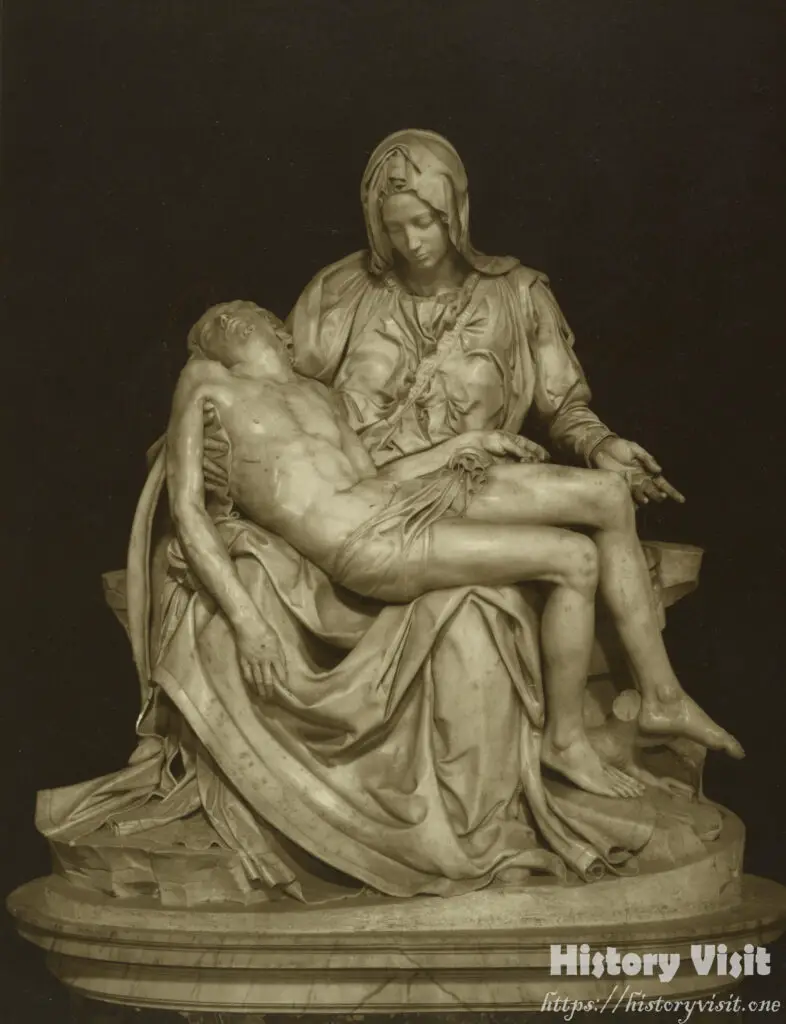
Michelangelo employed a range of artistic techniques in the creation of “The Pietà,” showcasing his extraordinary skill as a sculptor. Here are some of the key techniques he utilized
- Marble Carving: Michelangelo’s mastery of marble carving is evident in the precision and fluidity of the sculpture’s forms. He utilized traditional carving tools such as chisels, mallets, and rasps to shape the marble and create intricate details, from the delicate folds of fabric to the subtle contours of the figures’ bodies.
- Contrapposto: Michelangelo employed the contrapposto pose, a classical sculptural technique in which the weight of the body is shifted onto one leg, creating a sense of naturalism and movement. Mary’s gentle inclination and subtle twist of the torso convey a sense of grace and elegance, enhancing the realism of the composition.
- Anatomical Accuracy: Michelangelo’s meticulous attention to anatomical detail is a hallmark of his artistic style. He studied human anatomy extensively, often dissecting cadavers to gain a deeper understanding of musculature and form. This knowledge is reflected in the lifelike depiction of the figures in “The Pietà,” with every muscle, vein, and bone rendered with extraordinary precision.
- Emotional Expression: Michelangelo was a master at conveying emotion through gesture, expression, and pose. In “The Pietà,” he skillfully captures the profound grief of Mary and the serene acceptance of Jesus through their facial expressions, body language, and the subtle interplay of light and shadow.
- Draperies and Textures: Michelangelo’s rendering of fabric drapery is highly nuanced and expressive. He used the marble’s inherent qualities to create the illusion of soft, flowing fabric cascading over the figures’ bodies, adding a sense of movement and dynamism to the composition.
- Polishing and Finishing: Michelangelo employed various polishing and finishing techniques to enhance the luminosity and translucency of the marble. By carefully sanding and buffing the surface of the sculpture, he achieved a smooth, polished finish that accentuates the marble’s natural beauty and luminosity.
Overall, Michelangelo’s artistic techniques in “The Pietà” exemplify his unparalleled skill as a sculptor and his ability to imbue stone with a sense of life, emotion, and spiritual depth. The sculpture stands as a testament to his enduring legacy as one of the greatest artists of the Italian Renaissance.
Reception and acclaim at the time of creation
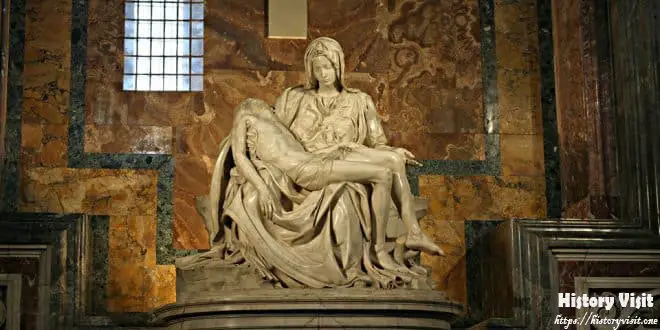
“The Pietà” was met with immense admiration and acclaim at the time of its creation, solidifying Michelangelo’s reputation as a master sculptor. Here are some aspects of its reception and acclaim
- Technical Mastery: Critics and contemporaries marveled at Michelangelo’s technical virtuosity in carving “The Pietà” from a single block of marble. The sculpture’s exquisite craftsmanship, intricate detailing, and lifelike realism were praised as unprecedented feats of skill and artistry.
- Emotional Impact: “The Pietà” elicited strong emotional responses from viewers, who were deeply moved by the portrayal of Mary’s tender embrace of her son’s lifeless body. The sculpture’s poignant depiction of maternal grief and divine grace resonated with audiences on a profound spiritual level.
- Spiritual Significance: As a religious work of art intended for a sacred space, “The Pietà” was revered for its spiritual power and theological depth. It served as a potent symbol of Christian devotion, inviting believers to contemplate the mystery of Christ’s sacrifice and the redemptive power of Mary’s maternal love.
- Cultural Icon: “The Pietà” quickly became a cultural icon, drawing pilgrims and admirers from far and wide to marvel at its beauty and significance. Its installation in St. Peter’s Basilica ensured that it would be seen by countless visitors, solidifying its place as one of the most revered and celebrated artworks of the Renaissance.
- Patronage and Recognition: Cardinal Jean de Billheres, who commissioned “The Pietà” for his future tomb in St. Peter’s Basilica, was delighted with Michelangelo’s work and praised him lavishly for his achievement. The sculpture’s success further solidified Michelangelo’s reputation as a preeminent artist and earned him the patronage and support of influential figures in the Roman Catholic Church.
Overall, “The Pietà” was hailed as a masterpiece of Renaissance art from the moment of its unveiling, garnering widespread acclaim for its technical brilliance, emotional resonance, and spiritual significance. Its enduring popularity and influence continue to captivate audiences centuries after its creation.
Influence on subsequent art and artists
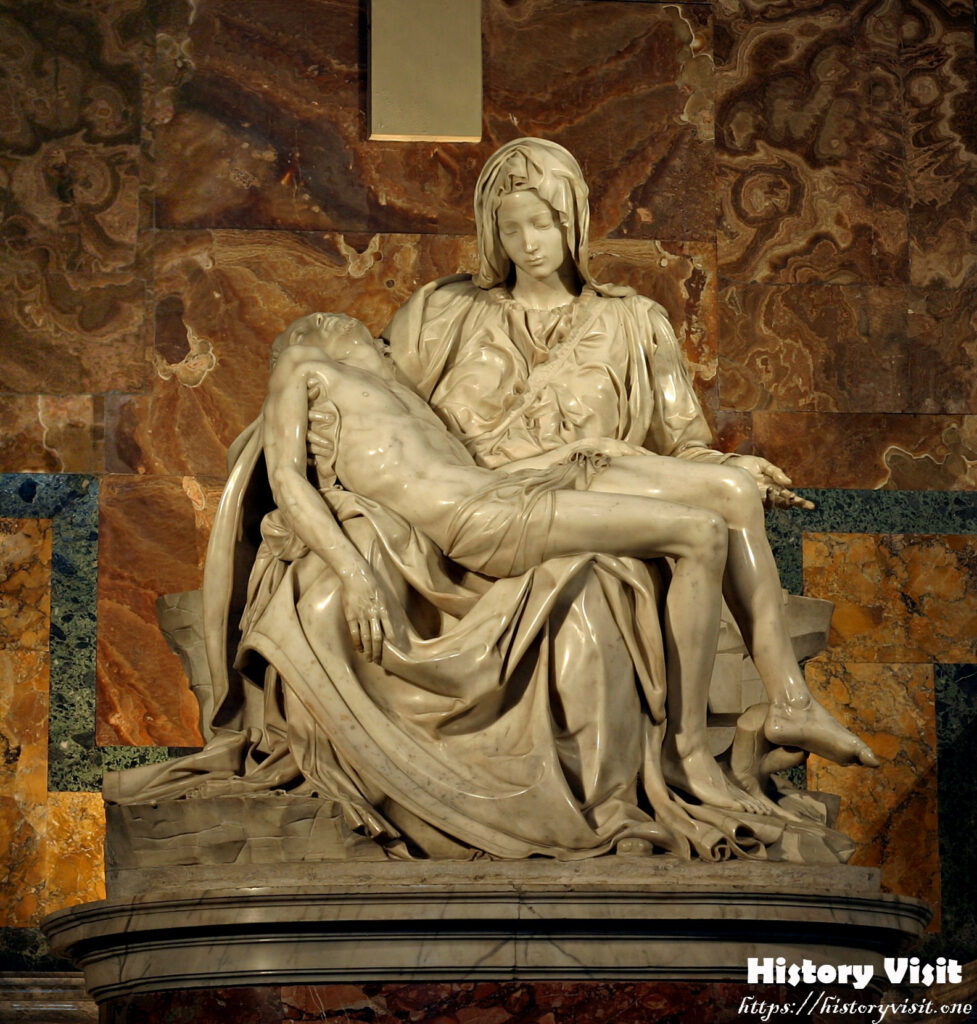
“The Pietà” by Michelangelo has had a profound influence on subsequent art and artists, both during the Renaissance and in the centuries that followed. Here are some key aspects of its influence
- Renaissance Sculpture: Michelangelo’s “The Pietà” set a new standard for Renaissance sculpture, inspiring artists to emulate its technical brilliance and emotional depth. Its naturalistic rendering of the human form and expressive portrayal of emotion influenced subsequent sculptors, who sought to capture similar levels of realism and pathos in their own work.
- Religious Art: “The Pietà” became a model for religious art, particularly depictions of the Virgin Mary and the crucifixion of Christ. Artists throughout the Renaissance and beyond looked to Michelangelo’s sculpture as a source of inspiration for their own interpretations of biblical subjects, seeking to evoke the same sense of spiritual devotion and emotional intensity.
- Baroque Art: In the Baroque period, artists such as Gian Lorenzo Bernini drew inspiration from Michelangelo’s sculptural techniques and emotional expressiveness. Bernini’s dynamic and theatrical approach to sculpture, characterized by swirling forms and dramatic gestures, can be seen as a continuation of Michelangelo’s legacy, albeit with a distinct Baroque flair.
- Neoclassicism: During the Neoclassical period, artists like Antonio Canova looked to the ideals of classical art for inspiration. While Canova’s style differed from Michelangelo’s in its emphasis on graceful forms and idealized beauty, “The Pietà” served as a touchstone for the Neoclassical revival of classical themes and motifs.
- Modern and Contemporary Art: Even in the modern and contemporary periods, Michelangelo’s “The Pietà” continues to exert influence on artists working in a variety of media. Its timeless themes of love, loss, and redemption resonate with contemporary audiences, inspiring reinterpretations and adaptations that explore the enduring relevance of its message.
Overall, “The Pietà” stands as a seminal work of art that has left an indelible mark on the history of Western art. Its influence can be seen in the work of countless artists across centuries and continents, attesting to the enduring power and significance of Michelangelo’s masterpiece.
Iconic status in art history
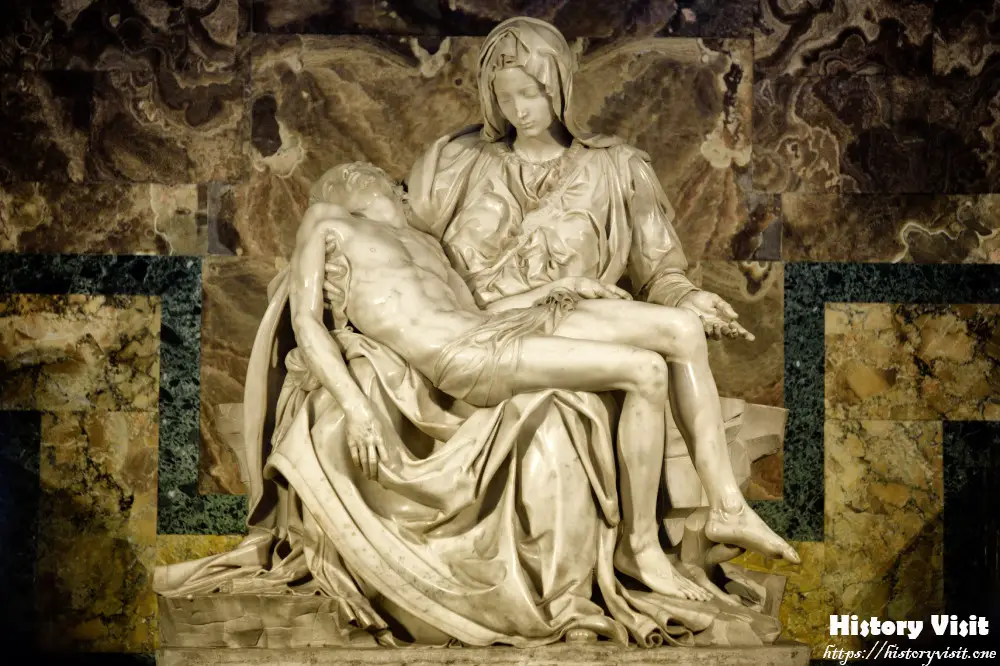
“The Pietà” holds an iconic status in art history for several reasons
- Masterpiece of Renaissance Art: As one of Michelangelo’s early masterpieces, “The Pietà” exemplifies the ideals of the Renaissance, characterized by a revival of classical aesthetics, humanism, and naturalism. Its exquisite craftsmanship, emotional depth, and spiritual resonance have earned it universal acclaim as one of the greatest works of art from this period.
- Technical Brilliance: Michelangelo’s virtuosity as a sculptor is on full display in “The Pietà.” Carved from a single block of marble, the sculpture showcases his unparalleled skill in capturing the human form with lifelike precision and expression. Its flawless execution and meticulous attention to detail have cemented its reputation as a triumph of technical mastery.
- Spiritual and Emotional Impact: “The Pietà” is renowned for its ability to evoke profound emotions and spiritual contemplation in viewers. Mary’s tender embrace of her son’s lifeless body conveys a sense of maternal grief and divine compassion that transcends religious boundaries and speaks to the universal human experience of love, loss, and redemption.
- Cultural Symbolism: “The Pietà” has become a cultural symbol of beauty, grace, and spiritual devotion. Its iconic imagery has been reproduced and referenced in various forms of media, from literature to film, attesting to its enduring popularity and influence as an emblem of Christian faith and artistic excellence.
- Enduring Legacy: Centuries after its creation, “The Pietà” continues to captivate audiences and inspire admiration for its timeless beauty and profound significance. Its iconic status in art history serves as a testament to Michelangelo’s enduring legacy as one of the greatest artists of all time and underscores the enduring power of art to transcend time, culture, and language.
Vandalism and restoration efforts
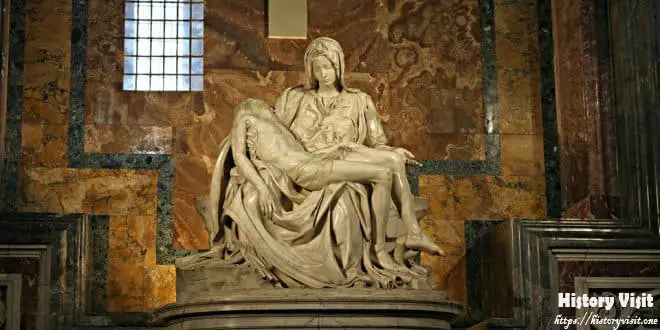
“The Pietà” has been the target of vandalism on at least two occasions, prompting significant restoration efforts to preserve this iconic masterpiece
- 1972 Vandalism: On May 21, 1972, “The Pietà” was subjected to an act of vandalism by a mentally disturbed geologist named Laszlo Toth. Toth attacked the sculpture with a geologist’s hammer while it was on display in St. Peter’s Basilica, inflicting significant damage to Mary’s arm, nose, and eyelids. The attack caused shock and outrage around the world and prompted immediate efforts to repair the damage.
- Restoration Efforts: Following the 1972 vandalism, skilled artisans and art restorers undertook a painstaking restoration process to repair the damage to “The Pietà.” Using traditional restoration techniques and materials, including marble dust and resin, they carefully reconstructed Mary’s damaged features and restored the sculpture to its original state. The restoration efforts were highly successful, and “The Pietà” was once again returned to public display, albeit with increased security measures in place to prevent future incidents.
- 1997 Incident: In 1997, a mentally disturbed man attacked “The Pietà” with a hammer, causing minor damage to the sculpture’s toes. The incident highlighted the ongoing vulnerability of priceless artworks to acts of vandalism and underscored the importance of robust security measures and vigilant conservation efforts to protect cultural heritage treasures like “The Pietà.”
Overall, while “The Pietà” has faced challenges from acts of vandalism, the dedication of skilled artisans and conservators to restore and preserve this iconic masterpiece has ensured that it continues to be treasured and admired by millions of visitors to St. Peter’s Basilica and art lovers around the world.
Conservation challenges and controversies
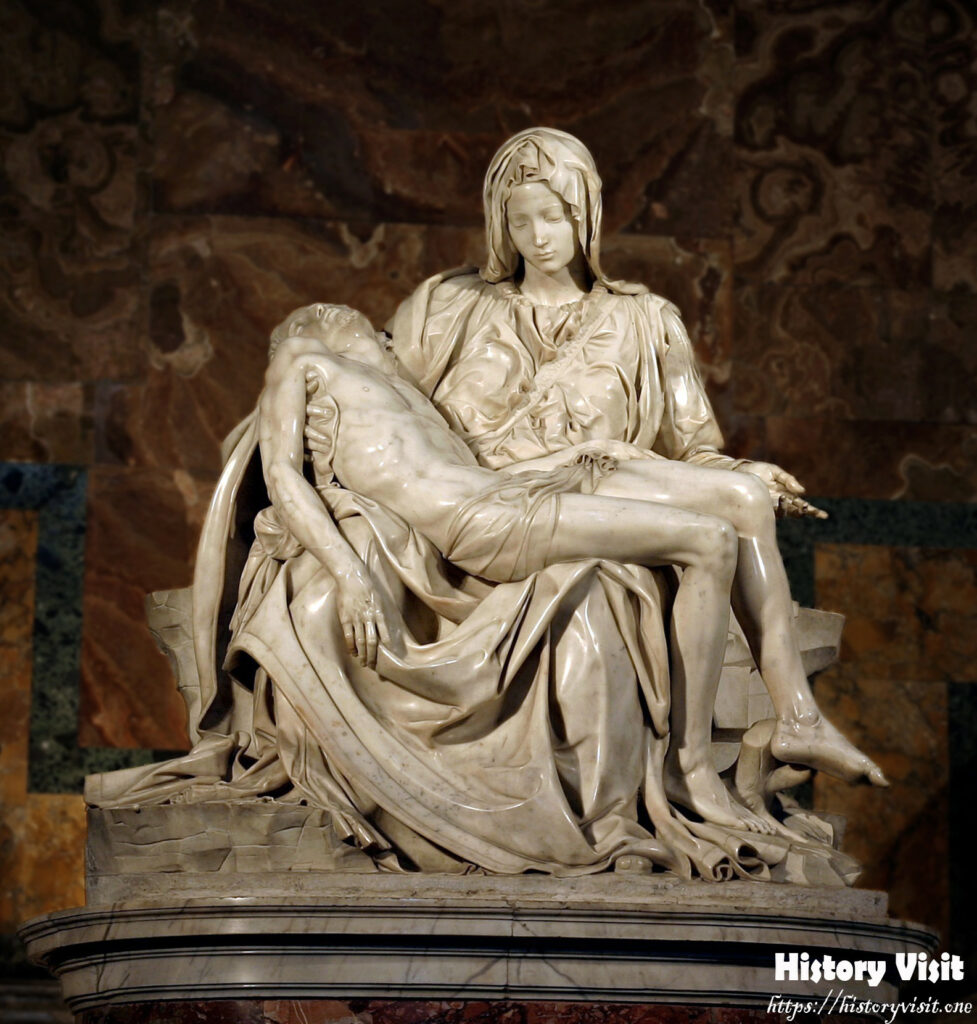
While “The Pietà” has been subjected to vandalism, conservation challenges, and controversies have also arisen concerning its preservation and display.
Damage from Pollution and Environmental Factors: Over time, exposure to pollutants, humidity, and fluctuations in temperature can cause deterioration to marble sculptures like “The Pietà.” St. Peter’s Basilica, despite being a magnificent structure, is not immune to environmental factors that can affect the artwork’s condition. Conservation efforts often involve monitoring and mitigating the effects of these environmental factors to prevent further damage.
- Restoration Techniques and Ethics: The restoration of historical artworks, including “The Pietà,” can be a contentious issue due to differing opinions on the appropriate techniques and level of intervention. Conservationists must carefully balance the preservation of the artwork’s original integrity with the necessity of repair and restoration. Controversies may arise regarding the use of modern materials, the extent of reconstruction, and the potential impact on the artwork’s authenticity and historical value.
- Display and Accessibility: The display and accessibility of “The Pietà” within St. Peter’s Basilica have also sparked debates. While the sculpture’s placement in a prominent location allows for widespread public access, it also exposes it to potential risks, including vandalism and damage from visitors. Some conservationists and art historians advocate for measures to enhance the sculpture’s protection and ensure its long-term preservation, such as installing protective barriers or limiting visitor access.
- Contemporary Conservation Practices: As conservation techniques and standards evolve, there may be debates over the most appropriate methods for preserving and maintaining historical artworks like “The Pietà.” New technologies and scientific advancements offer opportunities for more precise analysis and treatment of artworks, but they also raise questions about the preservation of authenticity and historical integrity.
In summary, conservation challenges and controversies surrounding “The Pietà” highlight the complex considerations involved in preserving and protecting priceless works of art. While efforts to safeguard this iconic masterpiece are ongoing, they require careful collaboration among conservationists, art historians, cultural institutions, and the public to ensure its continued enjoyment for future generations.
Public reactions and responses over time
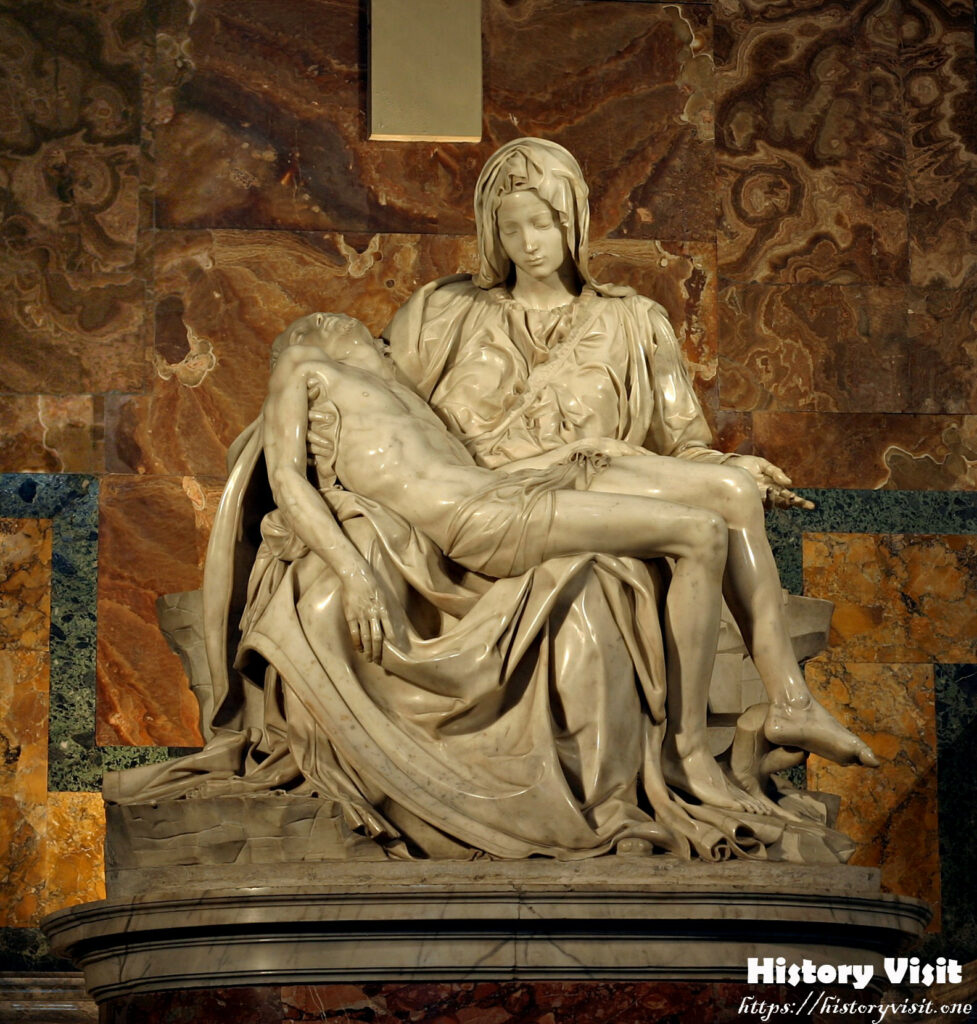
Public reactions and responses to “The Pietà” have evolved over time, reflecting changing cultural, social, and religious contexts. Here are some key trends in public reception
- Renaissance Admiration: During the Renaissance, “The Pietà” was celebrated as a masterpiece of art and a symbol of divine beauty and grace. Viewers were captivated by its exquisite craftsmanship, emotional depth, and spiritual resonance, and the sculpture garnered widespread admiration and acclaim from patrons, scholars, and the general public.
- Baroque Reverence: In the Baroque period, “The Pietà” continued to be revered as a sacred and inspiring work of art. Its emotional expressiveness and spiritual power resonated with Baroque sensibilities, and artists and patrons alike looked to Michelangelo’s sculpture as a touchstone for religious devotion and artistic inspiration.
- Romantic Idealization: During the Romantic era, “The Pietà” was idealized as a symbol of love, sacrifice, and the beauty of human emotion. Romantic poets and writers celebrated its emotional intensity and portrayed Mary’s maternal love and Christ’s suffering as emblematic of the human condition, inspiring countless literary and artistic interpretations.
- Modern Interpretations: In the modern era, “The Pietà” has been subject to a wide range of interpretations and responses, reflecting diverse cultural, religious, and ideological perspectives. Some viewers continue to admire its artistic beauty and spiritual significance, while others critique its religious symbolism or engage with it as a cultural artifact.
- Vandalism and Controversies: Incidents of vandalism and controversies surrounding the preservation and display of “The Pietà” have sparked public outrage and debate. Acts of vandalism, such as the 1972 and 1997 attacks, elicited widespread condemnation and prompted calls for increased security measures and conservation efforts to protect the sculpture from harm.
- Continued Reverence: Despite the passage of time and changing cultural attitudes, “The Pietà” remains a revered and beloved work of art, drawing millions of visitors to St. Peter’s Basilica each year. Its enduring popularity and influence attest to its timeless beauty, spiritual power, and significance as a cultural and religious icon.
Overall, public reactions and responses to “The Pietà” have been shaped by a complex interplay of artistic, religious, social, and historical factors, reflecting its enduring impact and relevance across centuries and cultures.
Recap of the significance of “The Pietà”
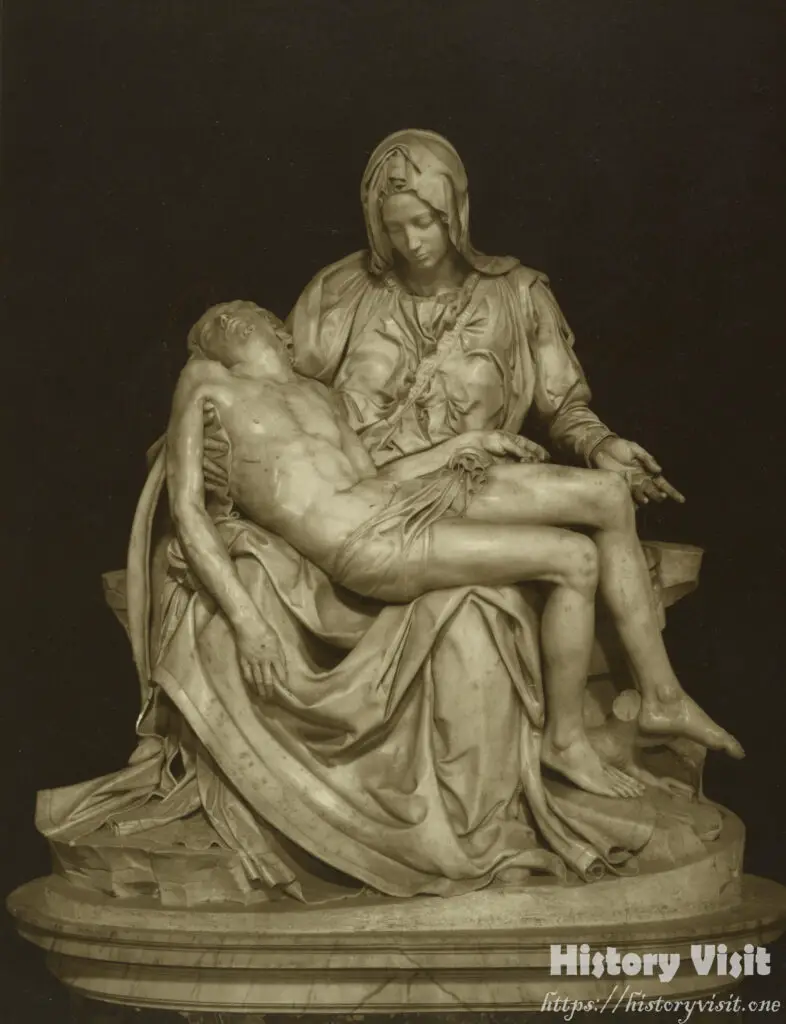
“The Pietà” holds immense significance in the history of art and the human experience, serving as a timeless symbol of beauty, grace, and spiritual devotion. Here’s a recap of its significance
- Artistic Mastery: Created by Michelangelo during the Italian Renaissance, “The Pietà” exemplifies the pinnacle of artistic achievement, showcasing the artist’s unparalleled skill in marble sculpture. Its exquisite craftsmanship, lifelike realism, and emotional depth have earned it universal acclaim as one of the greatest masterpieces of Western art.
- Spiritual Symbolism: As a portrayal of the Virgin Mary cradling the body of her son, Jesus Christ, after the Crucifixion, “The Pietà” embodies profound themes of love, sacrifice, and redemption central to the Christian faith. Its depiction of Mary’s maternal grief and Christ’s divine grace resonates with believers and non-believers alike, inviting contemplation of the mysteries of faith and the human experience of suffering and salvation.
- Cultural Icon: “The Pietà” has become a cultural icon, recognized and revered around the world for its beauty, significance, and influence. Its iconic imagery has been reproduced and referenced in various forms of media, from literature to film, attesting to its enduring popularity and relevance as a symbol of spiritual devotion and artistic excellence.
- Historical Legacy: Across centuries, “The Pietà” has left an indelible mark on the history of art, inspiring generations of artists, scholars, and viewers with its timeless beauty and profound message. Its enduring legacy serves as a testament to the power of art to transcend time, culture, and language, touching the hearts and minds of audiences across the globe.
In summary, “The Pietà” stands as a testament to Michelangelo’s genius, a masterpiece that transcends its historical and cultural context to speak to the universal themes of love, loss, and redemption. Its enduring significance lies in its ability to inspire awe, reverence, and contemplation, inviting viewers to engage with its timeless beauty and profound spirituality for generations to come.
Lasting legacy and continued relevance
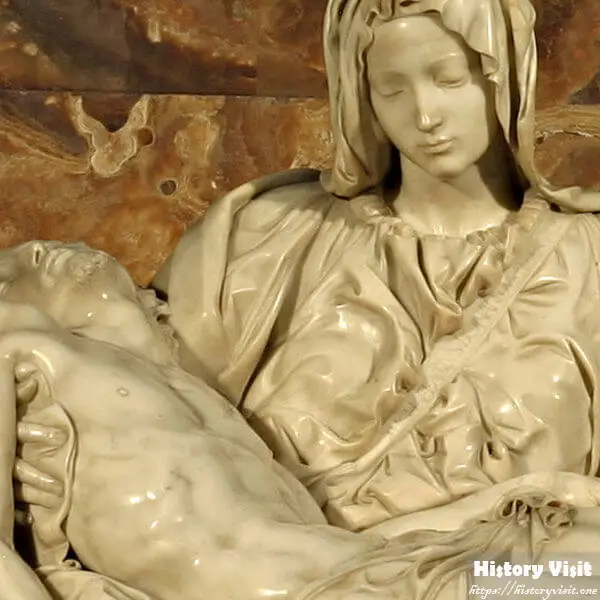
“The Pietà” continues to leave a lasting legacy and maintain its relevance across centuries for several reasons
- Artistic Inspiration: As one of Michelangelo’s most celebrated works, “The Pietà” serves as a source of inspiration for artists of all disciplines. Its exquisite craftsmanship, emotional depth, and spiritual resonance continue to captivate and influence generations of artists, who seek to emulate its beauty and power in their own creations.
- Cultural Symbolism: “The Pietà” has transcended its religious origins to become a universal symbol of love, compassion, and human suffering. Its iconic imagery resonates with people of diverse backgrounds and beliefs, serving as a potent reminder of the shared experiences that unite humanity across time and space.
- Spiritual Reflection: For believers, “The Pietà” remains a cherished symbol of Christian faith and devotion, inviting contemplation of the central tenets of the Christian narrative, including the crucifixion, resurrection, and the enduring bond between mother and son. Its depiction of Mary’s maternal love and Christ’s divine sacrifice continues to inspire spiritual reflection and reverence among worshippers and pilgrims.
- Historical Significance: As a masterpiece of Renaissance art, “The Pietà” occupies a prominent place in the history of Western civilization. Its enduring significance as a cultural and artistic landmark underscores its importance as a touchstone for understanding the evolution of art, religion, and society over time.
- Educational Value: “The Pietà” remains a valuable educational resource for scholars, students, and art enthusiasts interested in exploring the rich tapestry of Renaissance art and culture. Its study offers insights into the artistic techniques, religious symbolism, and historical context that shaped Michelangelo’s work and the broader artistic landscape of his era.
In summary, “The Pietà” continues to exert a profound influence on the worlds of art, culture, and spirituality, reaffirming its status as a timeless masterpiece that speaks to the enduring complexities of the human experience. Its legacy endures as a beacon of beauty, grace, and inspiration, inviting viewers to engage with its profound message of love, sacrifice, and redemption for generations to come.
Personal reflections on the impact of the sculpture
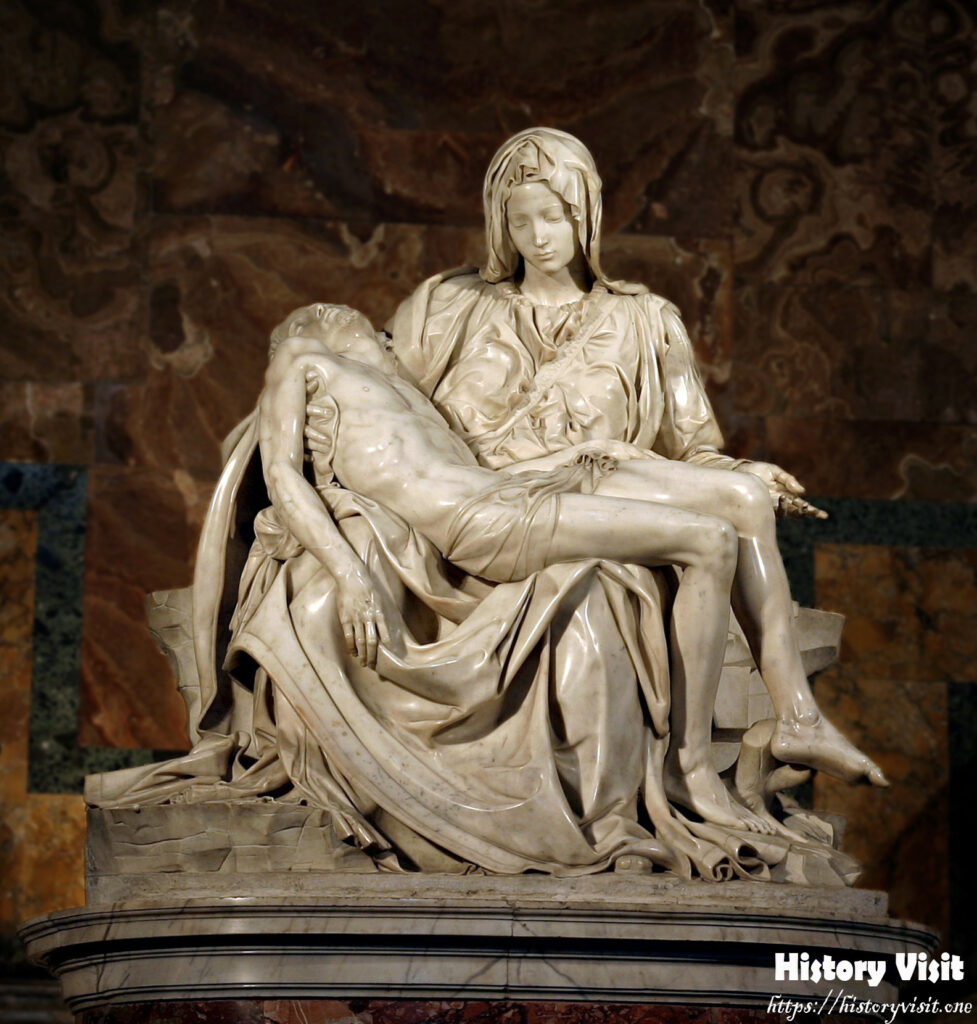
“The Pietà” holds a special place in the hearts of many, including myself, for its profound impact on both artistic and spiritual levels. As an admirer of art and a student of history, I find myself continually drawn to the sculpture’s timeless beauty and emotional depth.
On an artistic level, “The Pietà” exemplifies the pinnacle of human achievement in sculpture. Michelangelo’s skillful manipulation of marble to convey the delicate folds of fabric, the tender embrace of mother and son, and the subtle nuances of emotion is nothing short of breathtaking. The sculpture’s lifelike realism and technical brilliance serve as a constant reminder of the boundless creativity and ingenuity of the human spirit.
Beyond its artistic merits, “The Pietà” speaks to me on a deeply spiritual level. As someone who appreciates the power of symbolism and the beauty of religious imagery, I am moved by the sculpture’s portrayal of Mary’s maternal love and Christ’s divine sacrifice. In Mary’s sorrowful gaze and Christ’s peaceful countenance, I see echoes of my own experiences of love, loss, and faith, reminding me of the enduring power of compassion and redemption in the face of suffering.
“The Pietà” serves as a beacon of hope and inspiration in a world often fraught with pain and uncertainty. Its timeless message of love, sacrifice, and eternal grace continues to resonate with believers and non-believers alike, offering solace and comfort to all who encounter it. As I reflect on the impact of this extraordinary masterpiece, I am reminded of the transformative power of art to uplift the human spirit and illuminate the deepest mysteries of the soul.



Love the thrill of live dealer games and unique slot adventures-definitely hits the mark for casual fun. Big fan of platforms like for that seamless, secure experience.